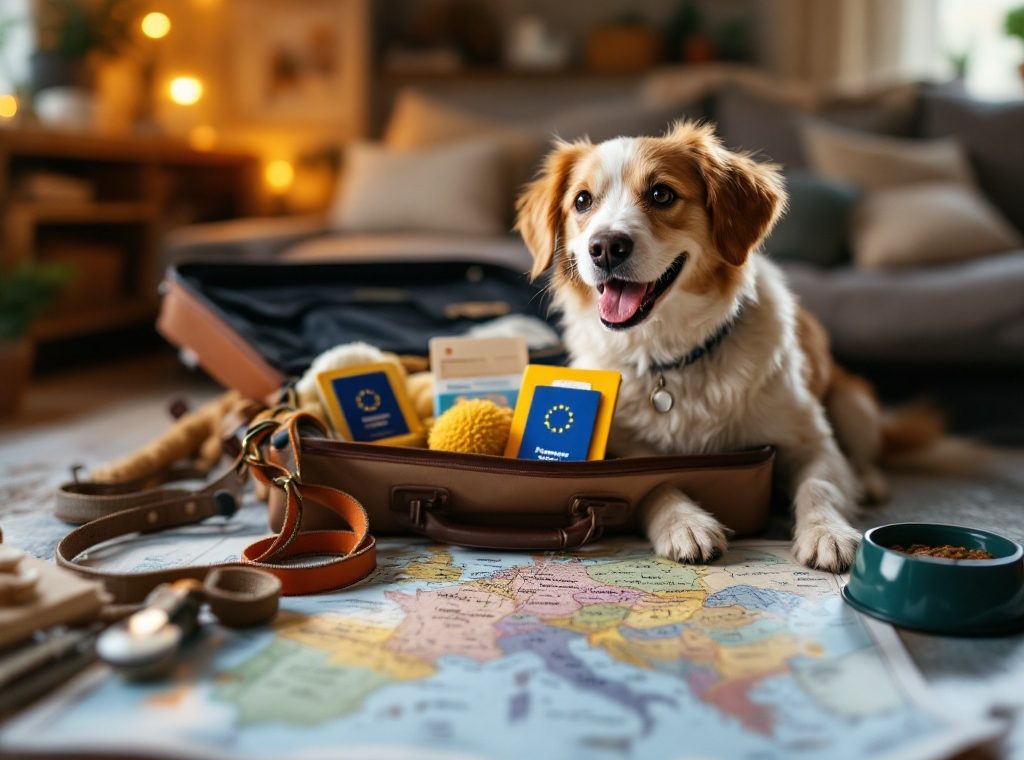Traveling to Europe with a Dog: Required Documents and Recommendations
Planning a European adventure with your furry friend? Navigating pet travel regulations can be tricky. This guide simplifies the process, outlining crucial documents like the EU Pet Passport and Animal Health Certificate. Discover essential rabies vaccination guidelines, microchip requirements, and airline policies to ensure a smooth journey. Prepare for a stress-free trip with our comprehensive checklist and expert advice. Learn more and travel with confidence!
Important information

- Your dog needs an ISO-compliant microchip (11784/11785) implanted before the rabies vaccine.
- A rabies vaccination is mandatory at least 21 days before travel to Europe.
- An EU Pet Passport is needed for travel within the EU, and an EU Animal Health Certificate is required for dogs arriving from outside the EU.
- Check specific pet import regulations for your destination country, including breed restrictions, quarantine rules, and required documentation.
- Confirm airline pet policies regarding carrier size, ventilation, and health certificates before flying.
Understanding Required Documents for Traveling to Europe with a Dog
Bringing your canine companion to Europe requires proper documentation. This generally entails an EU Pet Passport or, for dogs arriving from outside the EU, an EU Animal Health Certificate. The passport streamlines intra-EU travel and centralizes your pet’s health records. The certificate, conversely, confirms adherence to EU health regulations, ensuring a seamless entry for dogs originating from non-EU countries.
EU Pet Passport
Streamlines travel within the EU.
Centralizes your pet’s health records.
EU Animal Health Certificate
For dogs arriving from outside the EU.
Confirms adherence to EU health regulations.
Ensures seamless entry for non-EU dogs.
EU Pet Passport and Its Importance
Traveling with your pet within the EU is simplified by the EU Pet Passport, available from any authorized veterinarian in any member state. This essential document contains your pet’s microchip details, rabies vaccination records, and other important health information, confirming compliance with all EU travel regulations for smoother border crossings. Having a Pet Passport ensures hassle-free travel with your furry friend within the EU.
EU Animal Health Certificate: When It’s Necessary
Planning a European trip with your canine companion? Don’t forget the essential EU Animal Health Certificate. This document verifies your dog’s compliance with EU pet import regulations, confirming their health and rabies vaccination status, along with other important health checks. It’s a must-have for a smooth journey.
Microchip Requirements for Dogs Entering Europe
Your dog needs an ISO-compliant microchip (11784/11785) to enter Europe. This chip, implanted before the rabies vaccine, is essential for identification if your dog gets lost. It’s also crucial for the necessary travel documents, ensuring a safe return.
Rabies Vaccination Guidelines and Compliance
Traveling to Europe with your dog? Ensure a smooth trip by following these essential steps:
Rabies Vaccination: Administer a rabies vaccination at least 21 days before departure. This is mandatory and must be done by a licensed veterinarian.
Pet Passport: Ensure your dog’s rabies vaccination is properly documented in their pet passport.
Additional Requirements: Research your specific destination country’s pet import regulations. Some countries may require additional vaccinations, such as those for leptospirosis or distemper.
Complete Paperwork: Ensure all required paperwork is complete and up-to-date to avoid any travel issues.
Rabies Titer Blood Test: When It’s Needed
Some EU countries require a rabies titer test for dogs entering their territories. This blood test measures the level of antibodies against rabies, confirming the effectiveness of the vaccination and ensuring sufficient immunity against the disease.
Role of USDA-Accredited Veterinarian in Dog Travel
A USDA-accredited veterinarian simplifies international pet travel by handling the necessary health certifications. They ensure your pet complies with the destination country’s regulations and endorse the EU Health Certificate if needed, streamlining the entire process.
Navigating Pet Travel Regulations and Compliance
Traveling to Europe with your pet requires careful planning. Each country has specific pet import regulations, so research your destination’s requirements thoroughly. These typically involve documentation, health certifications, and border procedures.
Essential Requirements for Pet Travel to Europe:
- ID Microchip: ensure your pet has an ID microchip implanted.
- Rabies Vaccination: ensure your pet’s rabies vaccination is up-to-date.
- EU Animal Health Certificate (for travelers outside the EU): obtain an EU Animal Health Certificate from a certified veterinarian.
Additional Considerations:
- EU Pet Passport (for trips with five or fewer pets): an EU Pet Passport may suffice for smaller groups of animals.
- Consult a USDA-Accredited Veterinarian: a veterinarian can guide you through the necessary paperwork and procedures.
- Trips with More Than Five Pets: different rules apply for larger groups, so plan accordingly.
Customs and Document Verification Procedures
At customs, officials will thoroughly review your dog’s travel documents to ensure they meet EU requirements. This includes verifying the microchip and rabies vaccination records. They’ll accept a valid EU Pet Passport or an Animal Health Certificate. These checks help prevent issues upon arrival, ensuring a smooth entry for your pet.
Understanding EU Rules for Non-Commercial Pet Journeys
Bringing your pet to the EU for personal travel requires adhering to specific regulations. These rules are distinct from those governing commercial pet transport.
Microchip Identification
Your pet must be microchipped, meeting ISO standards 11784 or 11785. If not, a compatible microchip reader must be provided.
Rabies Vaccination
After microchipping, your pet requires a rabies vaccination. The pet must be at least 12 weeks old at the time of vaccination.
Waiting Period
A 21-day waiting period applies after the first rabies vaccination before travel. Subsequent vaccinations are valid immediately if administered before the previous one expires.
Tapeworm Treatment (for dogs only)
If entering Finland, Ireland, Malta, or Norway, dogs must receive tapeworm treatment administered by a veterinarian between 24 and 120 hours before arrival.
Health Certificate
An official veterinarian must complete an animal health certificate, validating the microchip, rabies vaccination, and tapeworm treatment (if applicable). Specific country requirements may apply.
Authorized Entry Points
Pets must enter the EU through designated Traveler’s Points of Entry, where documentation and pet compliance are verified. Check with your destination country for these points.
Step 1: Microchip Your Pet
Ensure your pet has an ISO-compliant microchip (11784 or 11785). If the microchip isn’t ISO-compliant, bring your own microchip reader.
Step 2: Vaccinate Against Rabies
Vaccinate your pet against rabies after microchipping. The pet must be at least 12 weeks old for the vaccination.
Step 3: Observe the Waiting Period
Adhere to the 21-day waiting period after the initial rabies vaccination. Subsequent booster vaccinations are valid immediately if given before the previous one expires.
Step 4: Treat for Tapeworms (Dogs Only)
If traveling to Finland, Ireland, Malta, or Norway, treat your dog for tapeworms between 24 and 120 hours before arrival. This treatment must be administered by a veterinarian.
Step 5: Obtain a Health Certificate
Acquire an animal health certificate from an official veterinarian. This certificate must confirm the microchip, rabies vaccination, and tapeworm treatment (if required). Be aware of any specific requirements for your destination country.
Step 6: Enter Through an Authorized Point of Entry
Enter the EU through a designated Traveler’s Point of Entry. Your pet’s documentation and compliance will be verified at these points. Confirm the authorized entry points with your destination country.
Traveling with More Than Five Pets: Special Rules
Bringing more than five pets across borders is considered commercial transport, which is subject to different rules than personal pet travel. These regulations vary by country. For example, the UK and France have distinct requirements. Therefore, it’s crucial to research your destination’s import rules and ensure your pets meet all health and vaccination standards.
Airline Policies and Pet Travel Requirements
Traveling with your pet? Here’s what you need to know about airline pet policies. The carrier must be appropriately sized and well-ventilated, whether your pet travels in-cabin or as cargo. A health certificate issued within 10 days of departure is mandatory. Each airline has specific pet policies, so check theirs beforehand.Quarantine regulations vary by country and sometimes even by airline. Some countries require quarantine, while others don’t. Airlines often have specific procedures for animals subject to quarantine. Confirm your destination’s quarantine rules and your airline’s policies before flying. This will ensure a smooth trip for both of you.
Considerations for International Flights with Dogs
Traveling with your dog requires careful planning, especially concerning airline regulations. Before booking your flight, research specific pet policies on the airline’s website, paying close attention to kennel size and weight restrictions. A pre-flight veterinary visit is essential to obtain the necessary health documentation. Ensure your dog has an ISO-compliant microchip (11784 or Annex A to 11785). Familiarize yourself with the airline’s approved crate types, as some have specific requirements. Acclimating your dog to the kennel before the trip can significantly reduce stress. Finally, ensure adequate ventilation within the kennel during the flight for your dog’s comfort and safety.
Quarantine Restrictions and Airline Policies
Traveling with your pet requires careful planning. Airline regulations vary, often including breed restrictions and specific crate requirements. Research your airline’s policies early in the planning process. Destination countries also have their own regulations, including possible quarantine periods depending on your origin and your pet’s health status. Consult your destination’s official government website for the most current quarantine information.
Recommendations for Traveling to Europe with a Dog
Ensure your dog’s rabies vaccination is current and administered at least three weeks before your departure.
Obtain an EU Pet Passport or an EU Animal Health Certificate from a USDA-accredited veterinarian.
Don’t forget copies of your dog’s complete vaccination records.
Investigate any breed-specific regulations at your destination, as some countries impose restrictions.
Certain breeds may face limitations, while others require additional documentation, such as proof of muzzle training or liability insurance.
Contacting the embassy or consulate will provide clarity on these breed-specific rules.
Locate veterinarians at your destination in advance and prepare a pet first-aid kit.
Keep your regular vet’s contact information readily available.
Ensure your dog wears ID tags with your contact details for a safe and worry-free trip.
Preparing Veterinary Records and Health Certifications
Before traveling internationally with your dog, gather the necessary documents.
Locate your dog’s rabies vaccination record.
Ensure your dog has an ISO-compliant microchip for identification.
Obtain a USDA-endorsed health certificate from an accredited veterinarian.
If traveling from outside the EU, a rabies titer test may be necessary.
Secure the appropriate travel documents: an EU Pet Passport is preferable if your dog qualifies; otherwise, an EU Animal Health Certificate will be required.
Managing Dangerous Dog Breeds: Regulations and Advice
Traveling to Europe with your dog? Research breed-specific regulations beforehand. Many countries restrict “dangerous” breeds, with rules varying from muzzles and permits to mandatory insurance. Some countries even ban certain breeds. Contact the relevant embassy or consulate for detailed information to ensure a smooth trip for you and your pet.
Emergency Planning for Pets During Travel
Traveling with your pet involves careful planning. First, research pet-friendly accommodations. Pack a pet first-aid kit containing antiseptic wipes, bandages, and required medications. Make sure your pet’s ID tags have updated contact information, and bring their health records, including vaccination and microchip details. Identify emergency veterinary clinics near your destination and create a plan in case of separation. Consider pet insurance for unexpected vet bills. Finally, learn the local pet regulations for public areas and transportation.
Find pet-friendly accommodations.
Prepare a pet first-aid kit with antiseptic wipes, bandages, and necessary medications.
Ensure your pet’s ID tags display current contact information.
Bring your pet’s health records, including vaccination and microchip details.
Locate emergency veterinary clinics near your destination.
Formulate a plan in case you and your pet get separated.
Consider pet insurance for unexpected vet costs.
Familiarize yourself with local pet regulations for public areas and transportation.






